Fodder beet gene pool from the VIR collection: diversity, potential
Автор: Sokolova Diana V.
Журнал: Овощи России @vegetables
Рубрика: Селекция и семеноводство сельскохозяйственных растений
Статья в выпуске: 4 (54), 2020 года.
Бесплатный доступ
Relevance. As a source of juicy feed for livestock, fodder beet plays a leading role among fodder root crops. It plays an important role to solve the problem of improving domestic feed production, since the production of fodder beet is the most balanced in terms of carbohydrate and protein complex. A large number of feed units from the area of sowing in a complex with a high yield, a balanced mineral complex and the possibility of long-term storage makes the crop in demand for the livestock complex in Russia. The VIR fodder beet collection has a rich gene pool and, given the lack of varieties and hybrids in the State Register of the Russian Federation, is a source of raw material for domestic breeding. The purpose of the study is to identify the potential of the collection of fodder beet in the most important areas of modern crop selection. Materials and methods. The experiment involved a representative sample of 190 accessions that were grown in the vegetable crop rotation of the Research and Production Base of Pushkin Laboratories of the VIR from 2015 to 2019. Description and biochemical studies were carried out according to the VIR Guidelines. Results. The characteristics of fodder beet cultivars with signs of high yield, productivity, resistance to abiotic and biotic factors, suitability for mechanized harvesting and storability were given. There was a manifestation of axenium resistance of the culture to cercosporosis due to morphophysiological characteristics of the leaf apparatus of plants. Conclusions. The VIR fodder beet collection has a wide variety and well-studied gene pool, which is the potential to create the modern varieties and hybrids of crops with a complex of economically valuable characteristics, which are necessary for their high-tech production.
Fodder beet, genetic sources, types of varieties, productivity, cercosporosis, monogermicity
Короткий адрес: https://sciup.org/140250298
IDR: 140250298 | УДК: 633.41(089):631.526 | DOI: 10.18619/2072-9146-2020-4-20-27
Текст научной статьи Fodder beet gene pool from the VIR collection: diversity, potential
R oot crops occupy an important place in providing livestock with juicy feed. A balanced diet of animals on the content of digestible protein and carbohydrates is necessary for productive mass building. Fodder beet plays a leading role among fodder root crops. It plays an important role in solving the problem to improve domestic fodder cropping, since the production of feed beets is the most balanced in terms of carbohydrate and protein complex. The optimal ratio of raw protein and carbohydrates is 1:1.2–1.5.
One of the advantages of the culture is high content of carbohydrates in it (mainly sucrose). Their number according to long-term data of the VIR biochemical laboratory varies from 9% to 13% with the accumulation from 15% to 16.6% of dry matter [1]. Good preservation of root crops until spring and the use of tops for silage preparation is also a significant advantage of the crop. The accumulation of betaine, which is a necessary feed additive in animal husbandry, in root crops allows to reduce costs and improve the quality of meat products. Betaine, contained in all varieties of root beets, contributes to better metabolism in animals, improves the quality of protein, and serves as an anti-stressor and hepatoprotector [2, 3]. Root crops are well stored in winter and suitable for feeding all types of livestock and poultry, especially dairy cows and pigs. Every 100 kg of root crops contain 8.511.3 feed units, 0.9 kg of digestible protein. The mineral composition of fodder beet is mainly represented by alkaline elements, which helps to neutralize the acids, contained in the silage, and thereby, eliminates the excessive acidity of gastric juice, which is formed when feeding silage, in animals [4].
Fodder beet gives a large number of feed units per hectare compared to carrots and turnips. Due to the high yield (up to 110-120 t/ha) of root crops and tops, fodder beet provides from 1.0 to 1.5 tons of feed units per a hectare under favorable conditions [5]. This variety of beet is affected by diseases much less than sugar and table ones and can be successfully grown both in the southern and more northern regions of the Russian Federation. The content of individual elements is associ- ated with a complex of reasons: a specific genotype, the point of cultivation, meteorological conditions of the year, the applied agricultural technology, the size of the root crop, etc. [6].
For 2020, the Russian State Register of Breeding includes 10 varieties and 18 hybrids of fodder beet only. For successful work of breeders, it is necessary to have a diverse, well-studied source material. Given the lack of modern varieties and hybrids of this crop in the Russian Federation and the importance of producing juicy feed for livestock, the analysis of the potential of the VIR collection is relevant and timely.
Materials and methods
The material for the study was 190 accessions of the VIR collection of fodder beet, which were studied by a set of characteristics during 2015-2019. This sample representatively reflects global diversity, as it includes accessions from 28 countries that produce this crop. The experimental part of the work was performed according to a unified methodology in the Research and Production Base of the Pushkin and Pavlovsky Laboratories of the VIR (Pushkin, Leningrad region). The area of the accounting plot was 10 sq. m; the repeatability of the experience was three times.
Observations and records were made in accordance with the VIR Guidelines for the Study and Maintenance of the World Collection of Root Crops [7].
Cercosporosis was detected using the following 5-point scale: 0 points – no affects; 1 – up to 20% of the leaf surface area is affected; 2 – 21-40%; 3 – 41-60%; 4 – 6180%; 5 – 81-100%.
The level of monogermicity of seed plants was estimated by counting of fruits/ stems on 10-centimeter segments of the main and 2-3 side shoots.
The content of dry substances’ mass was determined by weighing the average accession before and after drying in a drying cabinet at 105°C.
The obtained experimental data were processed by the standard methods of statistical analysis using Excel.
Results and discussion
World collection of fodder beet ( Beta vulgaris L. subsp. vulgaris var. crassa ) of the VIR is unique in its genetic diversity and origin. The collection has existed since 1928 and currently includes 443 accessions, which is 22% of the total collection of the genus Beta L. of the VIR.
At the beginning of the last century, fodder beet was one of the three most common fodder root crops in Europe. Breeding work was actively carried out in France,
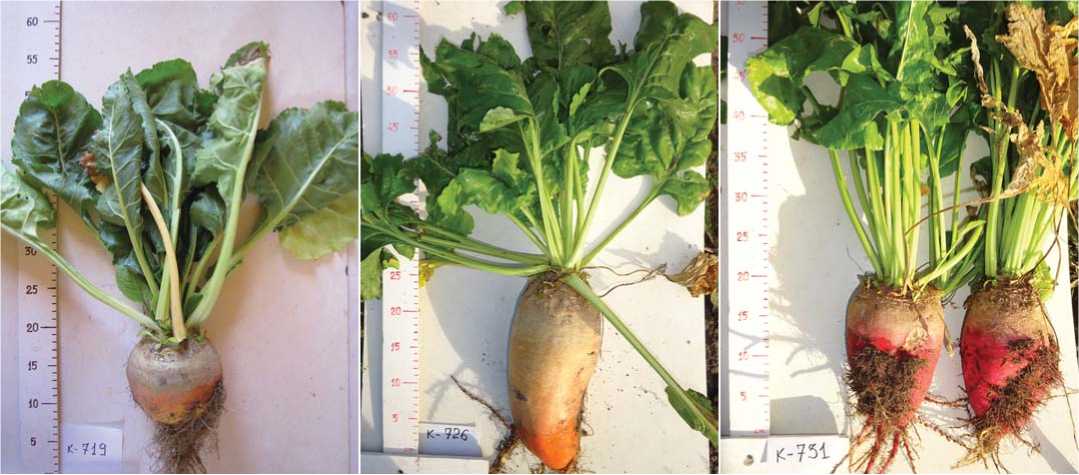
Fig. 1. The first accessions of the fodder beet VIR's collection
the Netherlands, Germany, Sweden, Denmark, Italy, and Great Britain. The first varieties appeared in the VIR collection in 1928. That year, the collection was supplemented with 58 accessions of fodder beet from European breeding companies. At that time, the main areas of breeding work were increasing yields, resistance to diseases and keeping (the ability of root crops to maintain their quality during long-term storage at low temperatures). Among the first arrivals there were the accessions from France – ‘Jaune Globe a petite fenille’ (k-719), ‘Jaune ovoide des Barres’ (k-726), ‘Eckendorfer rouge’ (k-731); the accessions of Dutch selection – ‘Barres Sludstrup’ (k-740), ‘Grosse glatte weisse’ (k-749); the Danish variety ‘Eckendorfer verbesserte gelbe’ (k-755); the German varieties – ‘Riesen Pfahl-lange rote’ (k-802),
Representatives of breeding in Denmark, Ukraine, Sweden and Belgium are after them (Fig.3). Characteristically there is no receipt of accessions from the countries of the southern hemisphere, and the interest in breeding with the crop is more characteristic of the countries of the northern hemisphere. The collection contains one local variety from Iraq ‘Red local’ (k-1833) – a 1960 expedition collection from the southernmost point.
Phenotypically, fodder beet accessions show the greatest polymorphism in terms of the main element of productivity – the root crop. According to the similarity of morphological features, all accessions are grouped into 11 groups – types of variety.
Characteristic features of the types of variety (Fig. 4): Eckendorf. Group of the types of variety: yellow ( var.
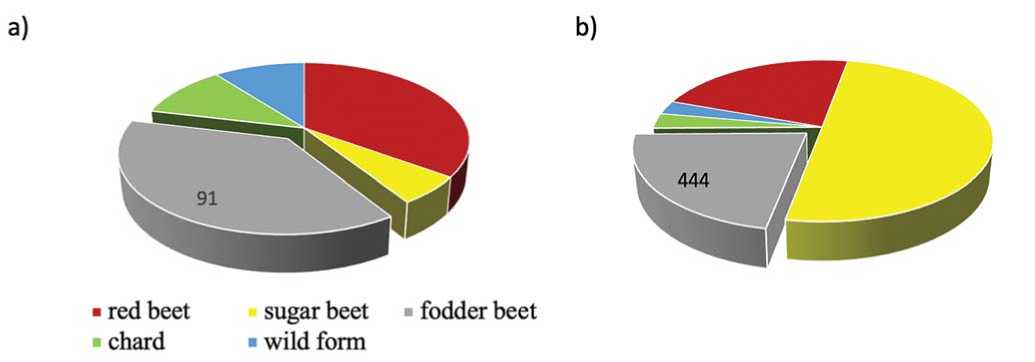
Fig.2. Structure of the genetic Beta L. collection of VIR in 1940 (a) and today (b)
‘Klumpen gelbe’ (k-813), ‘Eckendorfer gelbe Riesen Walze’(k-881) and etc. (Fig. 1).
The interest in the crop was quite great. In the first years of the collection’s existence, it was fodder accessions that made up the largest part of the collection (38%) until 1940 (Fig. 2). In subsequent years, the dynamics of new arrivals of fodder beet accessions was gradually reducing. To date, their share is 22% of all accessions of the Beta L. collection.
To date, the collection of fodder beet is represented by old-local varieties, diploid and polyploid variety populations, hybrids, linear materials, primitive and semi-sugar forms. The largest share is made up of selected varieties from the Netherlands, Germany, Russia and France.

Fig. 3. Countries - originators of collection accessions of fodder beet.
lutea ), white ( var. virescens m. ), and red ( var. rubidus m. ). It is a high-yielding group of accessions with a smooth root crop skin, convenient for cleaning and washing. It differs in the characteristic shape of the root crop: cylindrical or saccular one with a blunt base, often with an intercept in the middle. The immersion in the soil is shallow and therefore it easily extracts from the soil. It also tolerates lack of moisture relatively easily. The length of the growing season is 125-130 days. They are relatively resistant to bolting (2.45-6.3%), major diseases, and well-stored. Modern varieties are widely zoned, give a consistently high yield. The earliest specimens in the collection are: with yellow skin color – ‘Gul Eckendorfer’ (k-775, Sweden), ‘Eckendorfer gelbe Riesen Walze’ (k-881, Germany), ‘Ideal Poltavskiy’ (k-1471, Ukraine); with white skin color – ‘Grosse glatte weisse’ (k-749, Netherlands), ‘Weiss Gimsing’ (k-1961, Denmark), ‘Lange weisse’ (k-770, Germany); with red skin color – ‘Rubra schwedische rosakopfide’ (k-752, Netherlands), ‘Eckendorf red’ (k-1016, Netherlands), ‘Peragis Rote’ (k-2211, Germany). The accessions with white skin are less productive.
Barres. The oldest, most productive and most common type of the variety of fodder beet along with Eckendorf’s one. The history of the first variety goes back to 1853, when and the ‘Barres’ and ‘Vorjak’ varieties were developed from the ‘Yellow german’ variety by the Vilmorin Company. A distinctive feature is the orange color of the skin of the root crop. Its shape can be cylindrical or oval. This type of variety is characterized by an increased content of dry matter, less tendency to cer-cosporosis, good keeping and drought resistance.
BARRES TANKARD LEITEVITSKAYA ECKERDORF
Eckerdorf yellow
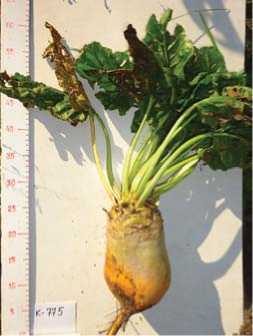
Gul Eckendorfer (k-775, Швеция)
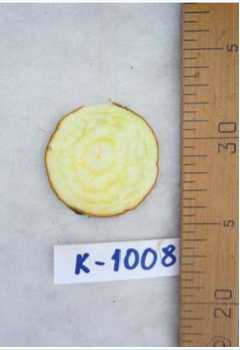
Eckerdorf red
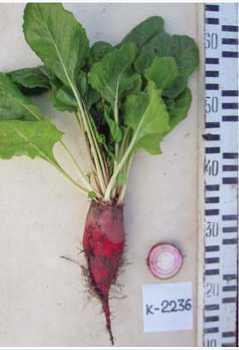
Peragis improved (k-2236, Latvia)
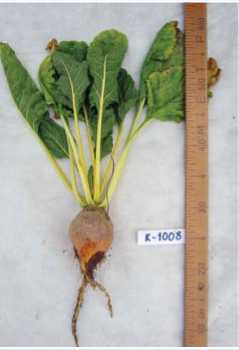
Eckerdorf white

Weiss Gimsing (k-1961, Denmark)
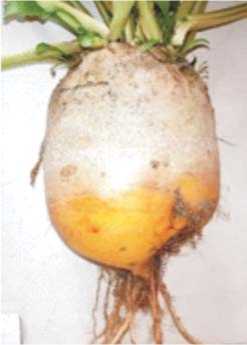
‘Champion Yellow globe’ (k-1008, United Kingdom)
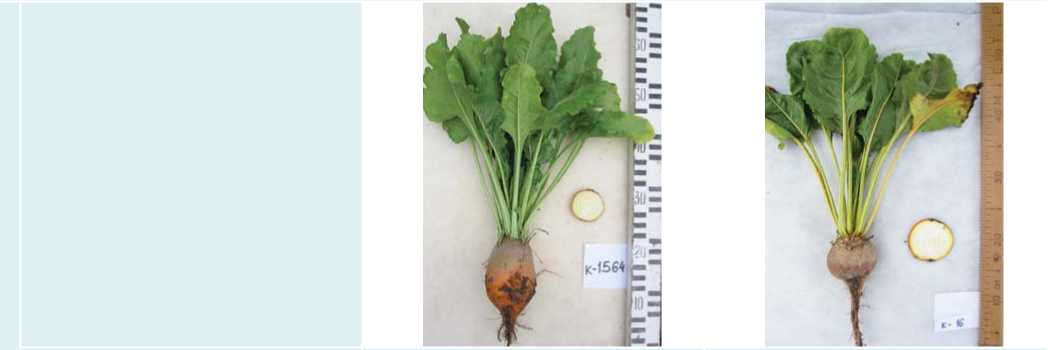
‘Golden Tankard’ ‘Jaune rouge sucree’
(k-1564, Russia) (k-16, France)

‘Barres Sludstrup’ ‘Siberian Orange’ ‘Poly Productiva’
(k-740, Netherlands) (k-3020, Russia) (k-2094, Netherlands)
GROVAS RED OTOFTE SEMI-SUGAR MAMMUT
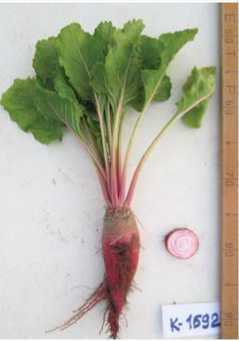
‘Mammut 1192’
(k-1592, Russia)
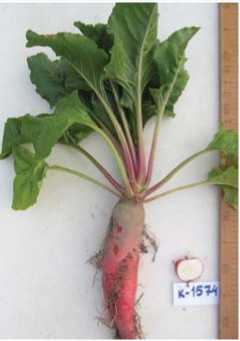
‘Mammut’ (k-1574, USA)
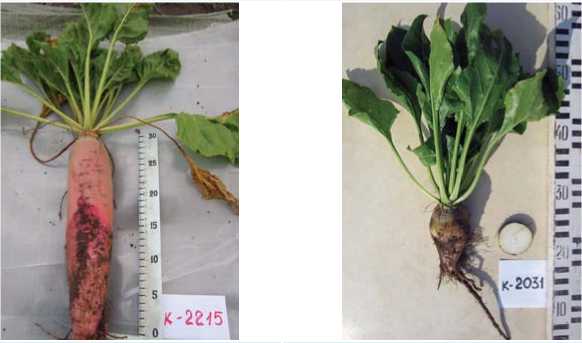
‘Kalininskaja rozovaja dlinnaja’ (k-2215, ‘Cherkesskaja polusaharnaja
Russia) belaja’ (k-2031, Russia)

‘Mars’ (k-1977, Czech Republic)
‘Favorite’
(k-1782, Netherlands)

‘Red otofte round’ (k-3152, France)
Fig. 4. Fodder beet of various types of varieties
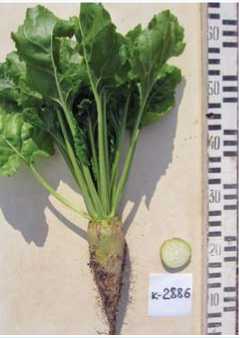
‘Cyklop Bumono’ (k-2886, Poland)
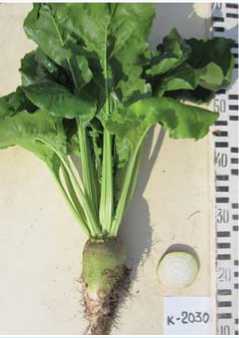
‘Zentaur’ (k-2030, Poland)
For the northern latitudes, our research institute created the variety of ‘Northern Orange’ (k-3334, author V.T. Krasochkin), the most resistant to bolting from fodder beet varieties. It has been included in the State Register of the Breeding Achievements of the Russian Federation since 1953 and is widely zoned on the territory of the country. The first varieties of the Barres type of variety are the progenitors of many modern varieties and hybrids of fodder beet. This type of variety is represented by ‘Barres Sludstrup’ (k-740, the Netherlands), ‘Barres cylindrical’ (k-1427, Russia), ‘Angora’ (k-3342, Belgium), ‘Siberian Orange’ (k-3020, Russia), ‘Barres Struno’ (k-1993, Germany), ‘Winner’ (k-1469, Ukraine), ‘Garant’ (k - 2129, Sweden), ‘Kolds Barres Stryno’ (k-2018, Germany), ‘Jaune Viking’ (k-2114, France), ‘Poly Productiva’ (k-2094, the Netherlands), and etc.
Leutewitz’s . A group of varieties of German origin. The color of the root crop skin is yellow and orange-yellow, the flesh is pale yellow. The shape of the root crop is rounded, the maximum weight reached 2.5 kg. Leaf blade is dark green; it easily tolerates autumn frosts. The rosette of leaves is powerful, approaching a standing form that does not prevent to use harvesting equipment.
The first additions to the collection in 1928 are ‘Leutewitzer’ (k-765, Germany), ‘Leutewitzer gelbe’ (k-794, Germany), and ‘Champion Yellow globe’ (k-1008, United Kingdom). This group of precocious non-bolting accessions is promising to grow in northern regions.
Tankard (var. aurantia m.). A small group of accessions of English origin. The type of variety is characterized by a golden-yellow color of the skin and flesh. Petioles and leaf veins also have yellow pigmentation. The rosette of leaves is small, semi-erect. Root crops do not exceed 600 grams, the yield is low, the dry matter content is increased. It relatively is resistant to bolting and drought. It does not tolerate excessive waterlogging. This type of variety is represented by of ‘Jaune rouge sucree’ (k-16, France), ‘Golden Tankard’ (k-835, Germany), ‘Golden Tankard’ (k-1564, Russia).
Mammut (var. rubidus m. ). The type of variety is characterized by a red-pink color of the root crop skin, slightly pinkish flesh and elongated conical shape. The leaf is pigmented; the leaf veins are maroon. The petiole is thin, long, and the rosette of leaves is spreading. In the 19th century, this type was widely distributed. It values for its consistently high content of dry matter – from 12% to 16%. It does not tolerate lack of moisture, but resistant to salinity. The varieties of this type are late-maturing, strongly affected by cercosporosis, and they require fertile soils. The tendency to branch leads to difficulty to extract from the soil. This type of variety is represented by ‘Mammut’ (k-1574, USA), ‘Mammut 1192’ (k-1592, Russia).
Semi-sugar. The group of the types of variety: pink (var. rosea Moq.) and white (var. virescens m. ), characterized by high sugar content and elongated or oval-conical shape of the root crop. In the group with white root crops, a subgroup of Owen’s accessions is distinguished – with an oval or shortened-oval shape. Some of the accessions were the primary forms of sugar beet at early last century, others came from crossing fodder with sugar one. This type of variety is resistant to both excess and lack of moisture in the soil. In the North, it produces a high percentage of bolting. The forms with white root crops contain more sugars (12-17%). The first representatives of this type of variety in the collection are ‘Polusakharnaya rozovaya’ (k-903, Ukraine), ‘Marienlyst 5’ (k-1348, Denmark), ‘Marienlyst 5 Gusrof’ (k-1028, Sweden), ‘Monorosa’ (k-2096, Germany), ‘Geante Blanche’ (k-727, France).
Red Otofte. The accessions of this type of variety are characterized by an oval and oval-conical shape of the root crop, red or crimson skin of the root crop with white or pink-
Table 1. Characterization of agronomic traits of fodder beets types (2015-2019)
Grovas. The shape of the root crop is oval or oval-conical, the skin and flesh are white. It has a high crop yield (up to 94% of the crop). This type of variety includes ‘Barron’ (k-2213, Netherlands), ‘Cyklop Bumono’ (k-2886, Poland), ‘Hinderupgaard’ (k-2393, Denmark), ‘Hunsballe Kora 7’ (k-1908, United Kingdom), ‘Porsina’ (k-2124, Romania), ‘Tekavil’ (k-2887, France), ‘Zentaur’ (k-2030, Poland).
In the breeding of fodder beet at this moment, the following main directions have now been determined: increasing productivity, resistance to diseases and pests, cold resistance and resistance to bolting, earliness, suitability for machine cleaning, keeping and monogermicity. These directions are connected with each other to a certain extent.
It is known that an important indicator of the productivity of fodder beet is the content of dry matter in root crops. In our study (Table 1), the accessions of different types of varieties differed in this feature, but all the experimental accessions showed a slight variability (Cv=17.1-12.0%). The stability of this indicator was noted earlier in other varieties of root beet [8]. The highest content of dry matter was observed in the types of the varieties of Barres, Semi-Sugar Pink, Semi-Sugar White and Grovas. There is no negative correlation between the weight of a single root crop and the dry matter content, which allows for the selection to increase the biomass without loss of productivity.
It is known that one of the factors determining the area of beet growing is temperature. Seedlings die in light frosts and negatively react to long-term spring cold spells, which usually induce bolting. Such plants dramatically reduce crop yield impairing the quality of products. Cold tolerance or resistance to the bolting of beets is important not only for northern and middle latitudes, but also for southern ones when sowing at early terms. The screening of genotypes for resistance to bolting in the conditions of Pushkin area revealed the types of variety: Leitevitskaya, Barres and Tankard (Table 2). The accessions from Sweden, the Netherlands, and the United Kingdom showed higher rates.
Cercosporosis is a disease caused by the pathogenic fungus Cercospora beticola Sacc. The disease manifests as multiple rounded grayish-brown necroses on leaves with a brown border measuring 2-4 mm. With epiphytotic course, the disease can lead to the loss of up to 30% of the yield. The genotypes of fodder beet being absolutely resistant to cercosporosis were not detected. The resistance, not specific to this species, due to the morphophys-iological characteristics of plants, was noted there. Thus, accessions with a smooth leaf surface, sparse and semiraised rosette of leaves were more resistant to the disease. The accessions of the types of the varieties Leitevitskaya, Semi-Sugar White and some representatives of the Barres had a similar architecture of the leaf rosette. It is interesting that in all the years of research, under equal conditions of growing, fodder beet was affected by Cercosporosis significantly less than table and leaf beet.
The most harmful beet disease in the north-west and central regions of Russia is a root rot disease caused by a complex of microorganisms: soil fungi and bacteria. The ratio and composition of pathogens varies significantly
Table 2. Characteristics of resistance and storage fodder beets types (2015-2019)
Keeping of fodder beet roots infected with cercosporo-sis and root rot is accompanied by their significant damage by pile rot, which leads to losses during keeping. We noted the deterioration of keeping quality and the high incidence of diseases in tetraploid accessions of fodder beet among all the types of varieties. In general, fodder beet has a good keeping for a long period and can keep root crops until the end of April at the level of 90-95% with proper agricultural techniques and favorable weather conditions.
The tendency to switch all grown varieties and hybrids of beet to monogerm forms is dictated by the need to mechanize the growing process fully. Sugar beet production around the world is almost completely switched to the use of monogerm seed material. The varieties of table and fodder beet are significantly behind in this parameter. The characteristic collection of single-seeded accessions of the VIR fodder beet is about 0.45% of all the accessions in the collection. The degree of monogermicity ranged from 95% to 99%. Such biotypes include the varieties and hybrids: ‘Avangard’ (k-3351, Ukraine), ‘Donor’ (k-2952, Ukraine), ‘Monovigor’ (k-2171, France), ‘Timiryazevskaya Single-Seeded’ (k-2948, Russia), ‘Smolevicheskaya’ (k-3039, Belarus), ‘Monogold’ (k-3350, Germany), ‘Monobamba’ (k-3553, the Netherlands), ‘Mono Fix’ (K-3568, France), ‘Svenska Redmono’ (K-3592, Sweden),
‘Monorosa’ (K-2096, Germany), ‘Monoblanc 1715’ (K-3335, the Netherlands).
The shape of the leaf rosette and the depth of immersion of root crops in the soil is an indicator of the possibility to use harvesting equipment on the crop. The accessions of the types of the varieties Eckendorf Yellow and Eckendorf Red are slightly (by 1/3-1/5) submerged in the soil, but they have a spreading form of leaf rosette. The type of the variety Eckendorf White is more suitable for mechanized harvesting, but is inferior in yield.
Thus, the VIR fodder beet collection reflects all the diversity of the crop and includes the necessary genotypes for the main areas of selection.
Conclusions
The analysis of varietal diversity of fodder beet from the VIR collection indicates significant changes in the directions of selection that have occurred over the past decades. In a number of European countries, intensive-type varieties with high yields and high dry matter content ensuring maximum quantity of fodder units from the area of sowing, have been developed. Also varieties and hybrids with a high degree of single-seeding, not inferior in yield to multi-seeded forms, obtained. Due to the directed breeding, a combination of a number of economically valuable traits and properties in one accession was achieved: high productivity, non-bolting, resistance to diseases and pests, adaptability to mechanized cultivation, and others. The study showed that the VIR collection of fodder beet has a wide variety, a well-studied gene pool, which makes it possible to conduct breeding work on a complex of economically valuable characteristics and create modern varieties and hybrids of the crop, which is necessary for high-tech production.
Об авторе:
Diana V. Sokolova – Cand. Sci. (Biology), Senior Researcher,
Список литературы Fodder beet gene pool from the VIR collection: diversity, potential
- Красочкин В.Т. Свекла. Москва. 1960. 438 с.
- Yu D.Y., Xu Z.R., Li W.F. Effects of betaine on growth performance and carcass characteristics in growing pigs. Asian-Aust. J. Anim. Sci. 2004;17(12):1700-1704.
- Muttarin Lothong, Kittipong Tachampa, Pornchalit Assavacheep, Kris Angkanaporn Effects of dietary betaine supplementation on back fat thickness and serum IGF-1 in late finishing pigs. Thai J Vet Med. 2016;46(3):427-434.
- Елисеев И.П., Шашкаров Л.Г., Елисеева Л.В., Ложкин А.Г. Нетрадиционные формы удобрений на пропашных культурах в биологи-зированном земледелии Чувашской республики. Чебоксары. 2019. 175 с.
- Карпусь М.М., Карпович С.И., Малиенко А.В. и др. Справочник питательности кормов. Под ред. М.М. Карпусь. [2-е изд. перераб. и доп.]. К.: Урожай, 1988. 400 с.
- Буренин В.И., Соколова Д.В. Адаптивный потенциал генресурсов кормовой свеклы. Сахарная свекла. 2016;(3):8-12.
- Буренин В.И. Методические указания по изучению и поддержанию мировой коллекции корнеплодов. Ленинград, 1989. 88 с.
- Соколова Д.В., Шеленга Т.В., Соловьева А.Е. Сравнительная характеристика биохимического состава образцов мангольда и свеклы столовой коллекции ВИР. Овощи России. 2019;(5):77-83. DOI: 10.18619/2072-9146-2019-5-77-83
- Буренин В.И., Юдаева В.Е. К проблеме селекции односемянных сортов столовой свеклы. Селекция и семеноводство. 1981;(1):19-21.


